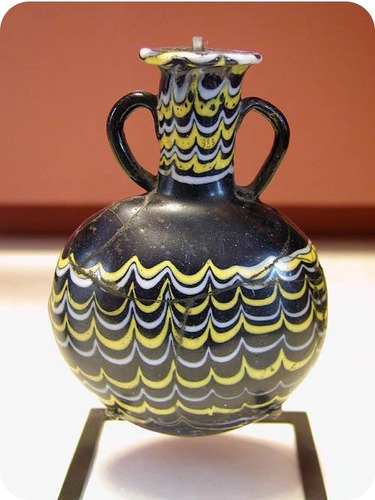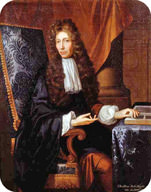1.2 化学史
章节大纲
-
Where did chemistry come from?
::化学从哪来的?Early “chemists” focused on practical questions – how to make dyes and perfumes, soap manufacture, uses of , and glass production among others. The goal was not to understand the physical world – that came later. People just wanted to make things that would improve their lives in some way.
::早期的“化学家”专注于实际问题 — — 如何制造染料和香水、肥皂制造、使用和玻璃生产等等。 目标是不理解物理世界 — — 后来出现的问题。 人们只是想要创造能以某种方式改善生活的东西。History of Chemistry
::化学史The history of chemistry is an interesting and challenging one. Very early chemists were often motivated mainly by the achievement of a specific goal or product. Making perfume or soaps did not need a lot of theory , just a good recipe and careful attention to detail. There was no standard way of naming materials (and no periodic table that we could all agree on). It is often difficult to figure out exactly what a particular person was using. However, the science developed over the centuries.
::化学史既有趣又富有挑战性。 早期化学家的动机往往主要来自特定目标或产品的实现。 制作香水或香皂不需要很多理论,只是一种好的秘方和细心的注意。 命名材料没有标准的方式(也没有我们所有人都能同意的定期表格 ) 。 通常很难确切地弄清楚某个特定的人在使用什么。 然而,科学是几个世纪以来发展起来的。Major progress was made in putting chemistry on a solid foundation when Robert Boyle (1637-1691) began his in chemistry. He developed the basic ideas for the behavior of . We could then describe gases mathematically. Boyle also helped develop the idea that small particles could combine to form molecules. Many years later, John Dalton used these ideas to develop the atomic theory.
::当罗伯特·博伊勒(1637-1691年)开始从事化学工作时,在将化学作为坚实基础方面取得了重大的进展。他为他的行为发展了基本的想法。然后我们可以用数学来描述气体。博伊尔还帮助发展了小粒子可以结合成分子的理念。许多年后,约翰·道尔顿利用这些想法来发展原子理论。Robert Boyle. The field of chemistry began to develop rapidly in the 1700s. Joseph Priestley (1733-1804) isolated and characterized several gases: oxygen, carbon monoxide, and nitrous oxide. It was later discovered that nitrous oxide (“laughing gas”) worked as an anesthetic. This gas was used for that purpose for the first time in 1844 during a tooth extraction. Other gases discovered during that time were chlorine, by C.W. Scheele (1742-1786) and nitrogen, by Antoine Lavoisier (1743-1794). Lavoisier has been considered by many scholars to be the “father of chemistry.”
::Joseph Pistricley(1733-1804年)分离了几种气体:氧气、一氧化碳和一氧化二氮,后来发现一氧化二氮( " 笑气 " )是一种麻醉剂,1844年在摘牙时首次用于这一目的,当时发现的其他气体是氯,由C.W. Scheeele(1742-1786年)和氮,由Antoine Lavoisier(1743-1794年)发现,Lavoisier(1743-1794年),许多学者认为Lavoisier是 " 化学之父 " 。Chemists continued to discover new compounds in the 1800s. The science also began to develop a more theoretical foundation. John Dalton (1766-1844) put forth his atomic theory in 1807. This idea allowed scientists to think about chemistry in a much more systematic way. Amadeo Avogadro (1776-1856) laid the groundwork for a more quantitative approach to chemistry by calculating the number of particles in a given amount of a gas. A lot of effort was put forth in studying . These efforts led to new materials being produced. Following the invention of the by Alessandro Volta (1745-1827), the field of electrochemistry (both theoretical and applications) developed through major contributions by Humphry Davy (1778-1829) and Michael Faraday (1791-1867). Other areas of the discipline also progressed rapidly.
::化学家们在1800年代继续发现新的化合物。科学也开始发展了一个更理论的基础。约翰·道尔顿(1766-1844)在1807年提出了他的原子理论。这一想法使科学家能够以更系统的方式思考化学。阿马迪奥·阿沃加德罗(1776-1856)通过计算一定数量的气体中的粒子数量,为更量化的化学方法奠定了基础。在研究方面付出了大量努力。这些努力导致了新材料的产生。在亚历山德罗·沃尔塔(Alessandro Volta)(1745-1827)发明后,通过Hummphry Davy(1778-1829)和Michael Faraday(1791-1867)的主要贡献开发了电子化学(理论和应用)领域(1778-1829)和Michael Faraday(1791-1867),其他学科领域也迅速发展。It would take a large book to cover developments in chemistry during the twentieth century and up to today. One major area of expansion was in the area of the chemistry of living processes. Research in photosynthesis in plants, the discovery and characterization of as biochemical , elucidation of the structures of biomolecules such as insulin and DNA – these efforts gave rise to an explosion of information in the field of biochemistry .
::需要一本大书来报道二十世纪和今天的化学发展。 一个主要的扩张领域是生活过程的化学领域。 植物光合作研究、发现和定性为生化、解释胰岛素和DNA等生物分子结构 — — 这些努力导致了生物化学领域信息的爆炸。The practical aspects of chemistry were not ignored. The work of Volta, Davy, and Faraday eventually led to the development of batteries that provided a source of electricity to power a number of devices.
::化学的实际方面没有被忽视,Volta、Davy和Faraday的工作最终导致电池的开发,为一些装置提供电力源。Battery developed by Volta. Charles Goodyear (1800-1860) discovered the process of vulcanization, allowing a stable rubber product to be produced for the tires of all the vehicles we have today. Louis Pasteur (1822-1895) pioneered the use of sterilization to eliminate unwanted microorganisms in wine and milk. Alfred Nobel (1833-1896) invented dynamite. After his death, the fortune he made from this product was used to fund the Nobel Prizes in science and the humanities. J.W Hyatt (1837-1920) developed the first plastic. Leo Baekeland (1863-1944) developed the first synthetic resin, widely used for inexpensive and sturdy dinnerware.
::Charles Goody (1800-1860年)发现了硫化过程,为我们今天拥有的所有车辆的轮胎生产了稳定的橡胶产品;Louis Pasteur(1822-1895年)率先使用绝育法来消除葡萄酒和牛奶中的不受欢迎的微生物;Alfred Nobel(1833-1896年)发明了炸药;Alfred Nobel(1833-1896年)在他死后,他从这一产品获得的财富被用来资助诺贝尔科学和人文奖;J.W Hyatt(1837-1920年)开发了第一颗塑料;Leo Baekeland(1863-1944年)开发了第一颗合成树脂,广泛用于廉价和坚固的餐具。Dynamite explosion in Panama, Central America (1908). Summary
::摘要-
Many civilizations contributed to the growth of chemistry.
::许多文明促进了化学的发展。 -
A lot of early chemical research focused on practical uses.
::许多早期的化学研究都集中在实际用途上。 -
Basic chemistry theories were developed during the nineteenth century.
::基础化学理论是在十九世纪形成的。 -
New materials and batteries are a few of the products of modern chemistry.
::新的材料和电池是现代化学的几种产品。
Review
::回顾-
Who invented the first battery?
::谁发明了第一个电池? -
What contribution to chemistry did Robert Boyle make?
::罗伯特·博伊尔对化学有何贡献? -
Who invented dynamite?
::谁发明了炸药? -
What was the first synthetic resin used for?
::第一个合成树脂是用来做什么的?
-
Many civilizations contributed to the growth of chemistry.



